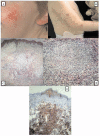Granulomatous skin lesions complicating Varicella infection in a patient with Rothmund-Thomson syndrome and immune deficiency: case report
- PMID: 21143835
- PMCID: PMC3009952
- DOI: 10.1186/1750-1172-5-37
Granulomatous skin lesions complicating Varicella infection in a patient with Rothmund-Thomson syndrome and immune deficiency: case report
Abstract
Rothmund-Thomson syndrome (RTS)(OMIM 268400) is a rare autosomal recessive genodermatosis characterized by poikiloderma, small stature, skeletal and dental abnormalities, cataract and an increased risk of cancer. It is caused by mutations in RECQL4 at 8q24. Immune deficiency is not described as a classical feature of the disease. Here we report the appearance of granulomatous skin lesions complicating primary Varicella Zoster Virus infection in a toddler with Rothmund Thomson syndrome and immune deficiency. Although granulomatous disorders are sometimes seen after Herpes zoster, they are even more rare after Varicella primary infection. Granulomas have hitherto not been described in Rothmund-Thomson syndrome. With this report we aim to stress the importance of screening for immune deficiency in patients with Rothmund-Thomson syndrome.
Figures

References
-
- Rothmund A. Ueber Cataracten in Verbindung mit einer eigenthumlichen Hautdegeneration. Arch Klin Exp Opthal. 1868;4:159–182.
-
- Thomson MS. Poikiloderma congenitale. Br J Dermatol. 1936;48:221–234. doi: 10.1111/j.1365-2133.1936.tb10332.x. - DOI
-
- Taylor WB. Rothmund-Thomson's syndrome. Arch Dermatol. 1957;75:236–244. - PubMed
Publication types
MeSH terms
Substances
LinkOut - more resources
Full Text Sources
Medical

